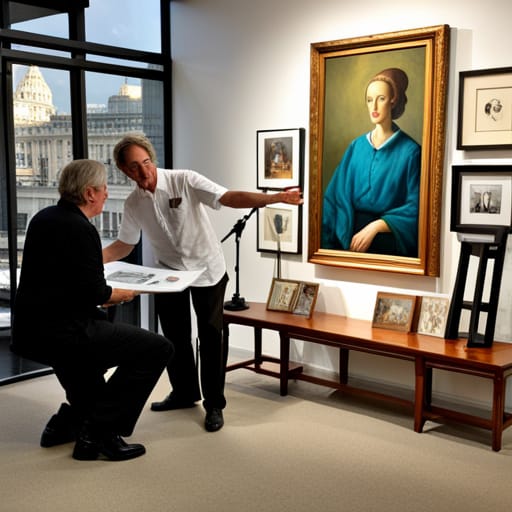Table of Contents
Pricing your art is almost as much of an art as creating it in the first place! Whether you’re a beginner, or a seasoned professional, knowing how to price your work can be difficult and confusing. This article is meant to remove the confusion, and guide you through the key considerations you can use to develop a methodology to price your work with confidence.
Understand Your Market
The deciding factor on whether a piece of art is worth $100 or $10,000 is… the market! What are your art buyers willing to pay?
The first thing you need to realise is that your work might be competing in more than one market. There is always your local market. However, you might also attend exhibitions in other locations, or sell your art online to a (potentially) global audience. These markets might vary considerably, and you might need to have a different pricing structure for each.
For example, if you’re located in a small town, then the prices for art will be substantially less than a place such as London, Toronto, or New York.
Whether you’re in a single market, or many, the first step is to research your market(s). Markets change over time, and the best way to stay on top of yours is to study what your competitors are doing.
Competitors? Yes, you do have competitors! You need to realise that if your goal is to sell art, then you are competing in a marketplace with other artists. Someone who buys a piece of art from you, might just as easily have bought it from another artist in your area (and vice versa).
You likely know the other artists in your area, but, if you don’t, make it a point to find out who they are. Choose a few artists in your market that you feel are similar in style, quality, technique, reputation, and prestige. Analyse how they are promoting themselves, what exhibitions or shows they are attending, and how much they charge for their work.
This will let you establish a price range for comparable work in your market(s).
Guidelines to Price Individual Pieces
Once you’ve established a range for similar work in your market(s), by artists with a similar skill level and reputation, you need to price your individual pieces within this market range.
Valuing your work based on your reputation
The price for art in a given market absolutely depends on the artists reputation. If you are an unknown, you cannot expect to command the same prices as an artist who is well-known and respected.
A common formula for pricing an individual piece that takes this into account:
- Multiply the width of the piece in inches by its length in inches to determine the area in square inches.
- Multiply the area by a dollar factor (i.e.: $ per square inch) based on your reputation and credentials.
- For example, for an unknown artist, this might be $2. For a known artist making their mark, it might be $3 to $5. For an artist with a solid reputation and following, it might be $6 or more.
- You can also calculate this factor based on analysing the vwork of your peers.
- If a piece is small, you might want to inflate this factor slightly (the effort is much the same as for a larger work). If the piece is a large-scale work, you might want to reduce it slightly so as not to price it out of the market.
- Double the cost of your materials (e.g.: canvas, paints, framing, etc.), and add this to the price from above.
- Round the result to the nearest hundred dollars.
Example:
- your painting is 24″ x 18″ = 432 square inches
- multiply this by your price per square inch based on your reputation and standing (assume $4): 432 x $4 = $1,728
- your canvas, paint, and frame cost $150, so, when doubled, this is $300
- add this to the area price: $1,728 + $300 = $2,028
- round this to the nearest hundred dollars to get a final selling price of $2,000
Valuing your work based on your time and effort
Some artists prefer to calculate the price of piece based on the time and effort they put into it. You would base this on an hourly rate you feel you are worth. Again, you need to double the cost of your materials, add it, and round the final price to the nearest hundred dollars.
- There are two problems with this approach:
- If you’re a beginner, it might take you longer to create a given painting than it would a more experienced artist. This method could price your piece higher than it might be worth.
- It’s much more difficult (or even impossible) to compare your hourly rate to those of your competitors because you have no direct way of knowing how much time and effort they expended for a comparable piece. You can ask them, but you should alsways take the answer with a large grain of salt.
Don’t Price Your Work Based on Emotion
You should be proud of your work. However, you must compare your work objectively to other art in your market(s), and not be swayed by an emotional attachment to a particular piece that might make you price it unrealistically high. This is not always easy to do, but you must do this.
If are too close to a specific artwork and feel that its reasonable market price is too low, keep it off the market in your private collection. Alternatively, exhibit it with a “Not for Sale” tag on it.
As soon as you show pieces that are unrealistically priced, buyers become sceptical of the pricing of the remainder of your work.
Embrace Your Market Pricing
Once you have established a price for an artwork based on market research and a rational approach to pricing, embrace this pricing and stand by it. After you have expended the time and effort to do your research, and to price your work realistically, you must be confident in the price you set.
Do Not Undercut Your Galleries
If you show your work in galleries, set a selling price that is identical to the price you would sell it directly to a buyer.
Yes, galleries charge a commission. However, you should think of this as fee you pay for the very real service that a good professional gallery offers to the artist (advertising, promotion, knowledgeable in-house sales staff, shipping, etc.). If a gallery’s commission is out-of-line with the benefits they provide, don’t exhibit there.
If you are found undercutting the prices the galleries charge, then your reputation amongst the galleries in this market will be tarnished, and these exhibition opportunities might dry up.
Conclusion
I hope this article will give you some guideance in establishing a reasonable pricing strategy for your market(s) that will let you be competitive while being fairly compensated for your work.




